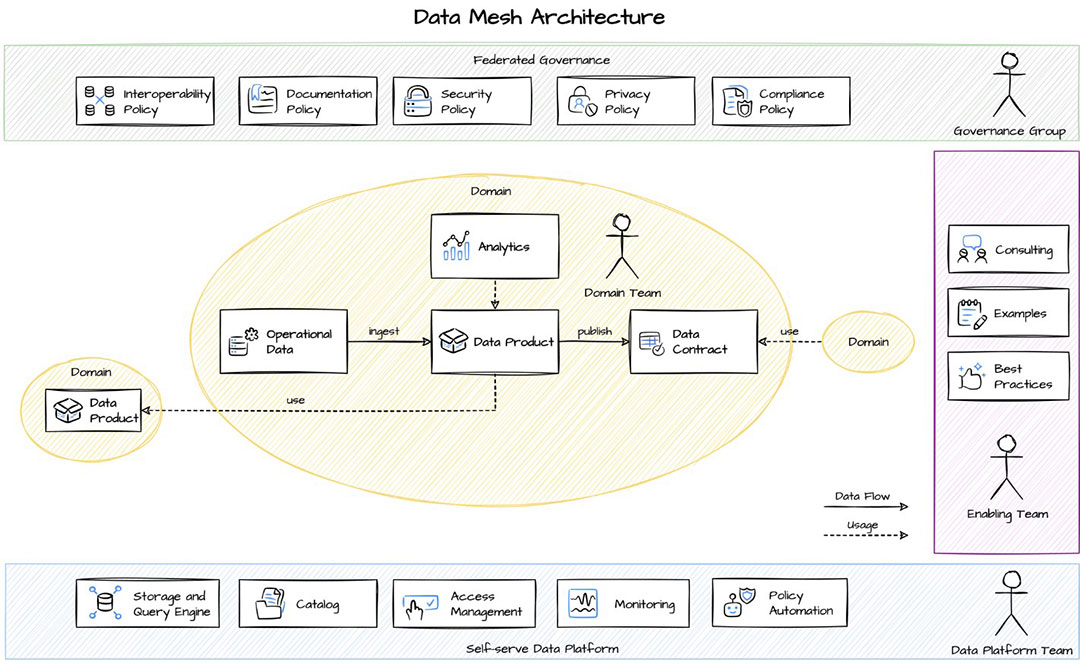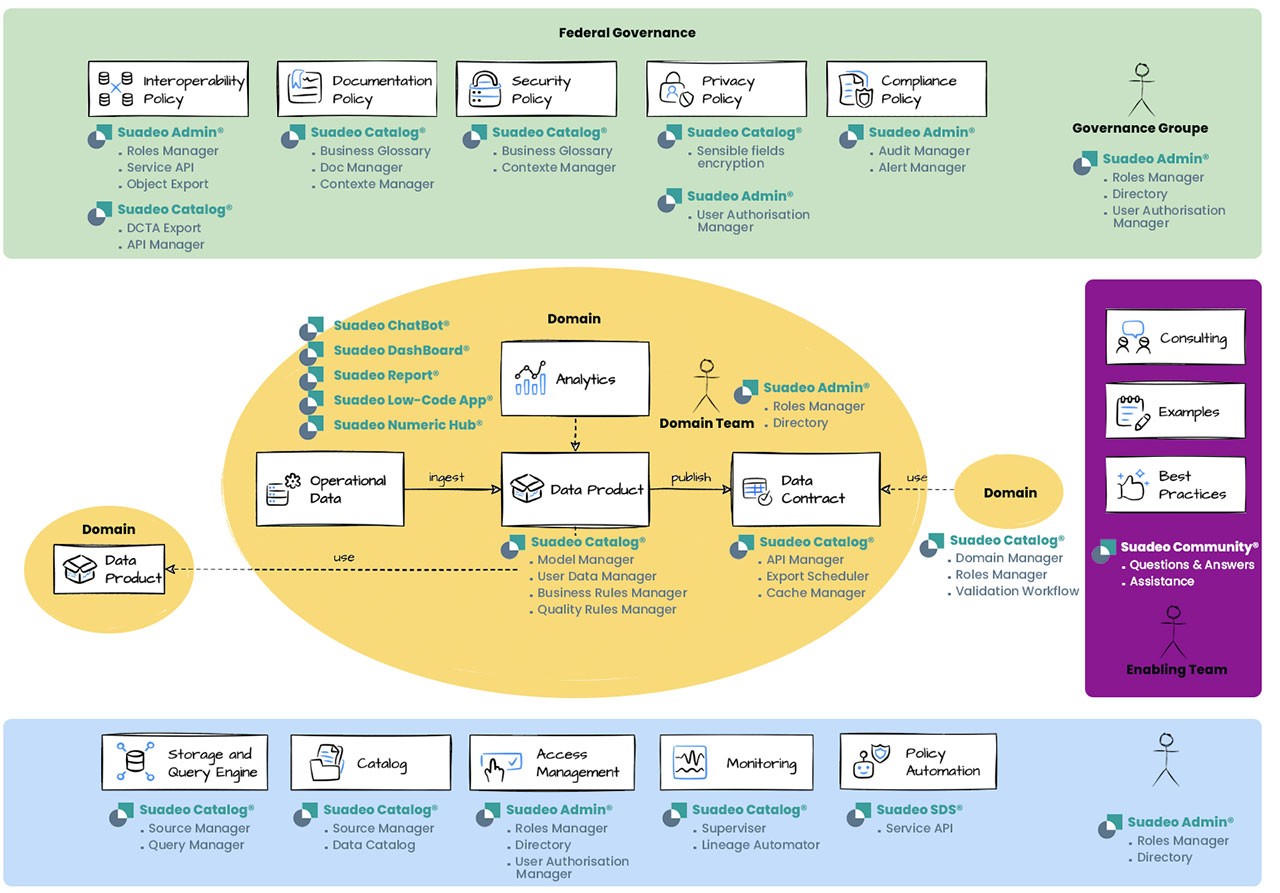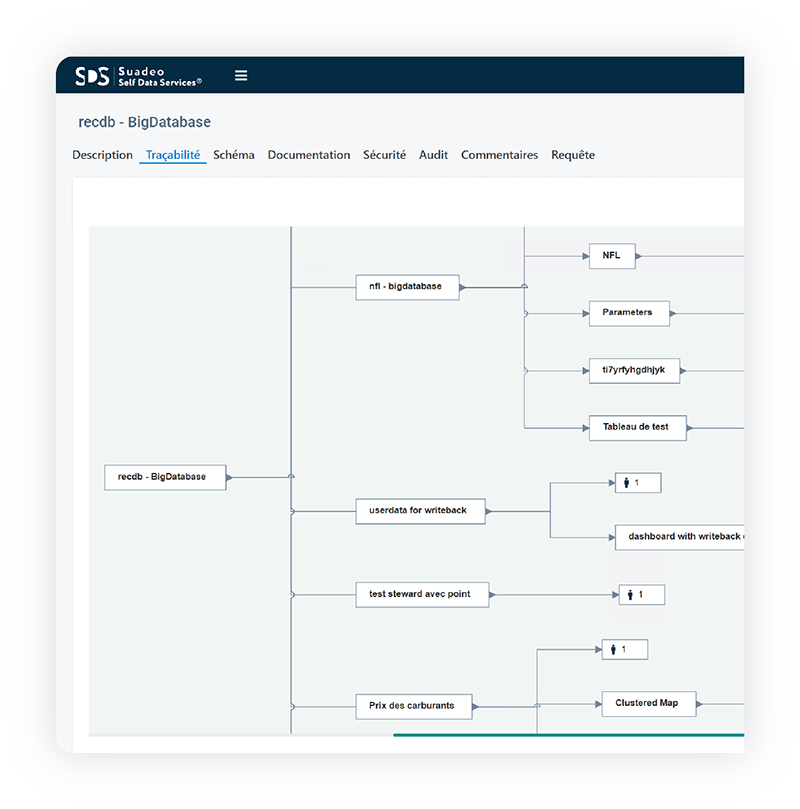Data Mesh
Data Mesh is not a concept for Suadeo.
This is our architecture!

Before it became a trend, we were already practicing Data Mesh, having deployed it for our customers for several years!
Suadeo’s platform is the only solution on the market that fully implements the Data Mesh architecture.
Our Research and Development has produced the Suadeo Self Data Services® platform in its design and operation in an inherently Data Mesh architecture.
Data Mesh, Kézako?
Data Mesh is an innovative approach to data management that revolutionizes the way companies structure and exploit their information assets.
Unlike traditional centralized architectures, Data Mesh proposes a decentralization of data management responsibilities, aligned with the operational areas of the company.
By adopting the principles of decentralized governance, domain ownership and Self-BI, Data Mesh allows local teams to manage, control and consume data autonomously.
This approach promotes greater agility, increased scalability and optimized responsiveness to evolving business needs.
For companies seeking competitiveness and innovation, Data Mesh represents a real cultural and technological transformation, paving the way for a more efficient and democratized exploitation of data.
Suadeo’s platform is natively Data Mesh.
Introduced in 2019 by Zhamak Dehghani when she was Chief Technology Officer at ThoughtWorks, the Data Mesh concept has been the foundation of the Suadeo platform for 20 years.
An essential prerequisite for true BI-self.
What defines a Data Mesh architecture within the market context?
The visual representation below illustrates the concept of Data Mesh, emphasizing the specific accountable stakeholders and thematic domains that demand focus, as detailed on the website www.datamesh-architecture.com.

Every Data Mesh architecture need can be met through a service provided by the Suadeo Self Data Services platform


The Suadeo Data Mesh concept is more than just a theoretical idea; it’s a concrete representation of our architecture
Since 2004, our guiding principle has been to simplify the extraction of value from data and its practical application by end users.
The services within our platform have been developed in close collaboration with these end users, providing them with autonomy and agility by reducing their dependence on IT interactions.
Step into the realm of Federated Governance!
Cultivate a data-centric culture that champions transparency, accountability, and a breeding ground for innovation
Interoperability Policy
Documentation Policy
Security Policy
Privacy Policy
Compliance Policy
However, our integrated services provide the means for an immediate deployment of Data Mesh

Virtualized Querying:
Data Sources:
Model:
Technical teams develop business models to improve data comprehension for end users. This abstraction layer enhances end-user autonomy and simplifies maintenance for technical teams.
Usage Data:
These are virtualized datasets curated by business units to address specific use cases. Secure and adaptable, these usage datasets can be contextualized based on user profiles and permissions.
Supervisor:
Catalog:
Data Catalogs:
Business Glossary:
Lineage:
Dashboards and Reports:
Customized Application:
API:
Scheduler:


Data Quality Rules:
Management Rules:
Directory / Groups:
User Roles:
Domains:
Tags:
Supervision:
Documentation:
Data Anonymization:
Audit:
Profiling:

10 reasons to adopt a Data Mesh architecture
Embrace a data-centric architecture to maximize the value and optimization of your data
Autonomy
Shared Knowledge
Your business functions grow together as they integrate and exchange data
Flexibility
Responsiveness
Quality
Each business unit takes responsibility for the quality of its own data, leading to a positive impact across all teams
Centralized
Communication
Enhanced data management communication through shared vocabulary and language
Scalability
Enable more straightforward evolution of your data architectures by dividing responsibilities among multiple teams

All our services to ensure data governance
Connector
Integration
Data Models
Usage Data
Data Catalog
Query
Dashboard
Report
Low code app
Chatbot


Suadeo: 20 years of RD
We were pioneers in Data Mesh before it became a trend!
Book your demo
Suadeo is the european Data and AI platform that gives organizations 100% control, visibility, and operational intelligence over their entire data assets.
Duration: 30 minutes
Format: Video conference
Hundreds of companies have chosen Suadeo : ask us why!

Speak with our experts
Got a project? Request a demo



